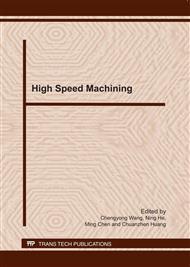p.307
p.314
p.319
p.325
p.330
p.336
p.340
p.344
p.348
Research on the Topography Features of the Densely Bonded Diamond Grinding Wheel Dressed by Elliptical Ultrasonic Vibration
Abstract:
In this paper, on the influence of different dressing methods, such as elliptical ultrasonic vibration, on the grinding wheel bonded delta, the morphology of abrasive grains of wheel, the protrusion height and the grinding wheel topography was studied by experiment. The experiment shows that the abrasive grains of grinding wheel surface dressed by elliptical ultrasonic vibration are great in protrusion height and trench depth, and the bonded delta grain after grinding is narrow, short, and irregular with significant reduced semi-surrounded area compared with by ordinary dressing method. The abrasive grains of metal-bonded diamond grinding wheel surface dressed by elliptical ultrasonic vibration are basically intact, and due to the high-speed collision between abrasive grains, local micro-break is easy to occur on the abrasive grains to form multiple micro-cutting edges. The abrasive grains of grinding wheel surface dressed by ordinary dressing method are fractured and broken, while that of resin-bonded grinding wheel surface have a high ratio to be loose and shedding. For the metal or resin-bonded grinding wheel surface dressed by elliptical ultrasonic vibration, its material removal mechanism may primarily be the removal of bonding ductility and the fine-crushing of abrasive grains; for the metal-bonded grinding wheel surface dressed by ordinary method, its material removal mechanism may primarily be the fracture and break of abrasive grains, secondly be the fracture of bonding agent; and for the resin-bonded grinding wheel surface, its material removal mechanism may mainly be the looseness and shedding of abrasive grains caused by the fracture of bonding agent, secondly be the fracture of abrasive grains. Compared with ordinary dressing method, elliptical ultrasonic vibration dressed abrasive grains are dense at shaft and sparse in periphery, with a large quantity of static effective abrasive grains, great protrusion height and an excellent nature of contour.
Info:
Periodical:
Pages:
330-335
Citation:
Online since:
March 2011
Price:
Сopyright:
© 2011 Trans Tech Publications Ltd. All Rights Reserved
Share:
Citation:


